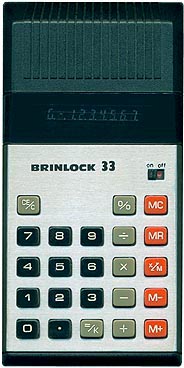
The Brinlock 33 is a handheld calculator from around 1977. It measures approximately 70mm x 136mm x 23mm (width, height, depth) and weighs 98g without batteries. The case is made from black plastic with a ridged top section that holds a 9V battery. There is also a socket on the side for an optional 7.5V DC adapter.
The front has a bright eight digit green vacuum fluorescent display (VFD) with a ninth digit for memory and error flags. Below this is an aluminum panel that wraps around the edges, marked with the model name and on/off switch. The keys make a positive click when pressed.

Inside, the main circuit board floats above the keyboard assembly which connects via a ribbon cable. The components include a General Instruments CF585 microprocessor, NEC display tube, transistors, diodes, capacitors and resistors.
The Brinlock 33 features the four basic math functions, percentages, and a five function memory. It shows overflow errors and has automatic constant on all operations. However, it is limited to eight digit negative numbers and suffers from the divide by zero bug. The memory overflow is not indicated, but errors can be stored in memory and recalled. Overall the logic capabilities were fairly basic for the late 1970s.
The Brinlock 33 was a reasonably well constructed calculator for its time, despite some logic limitations. It came from a lesser known British manufacturer but copied the popular handheld styling of the period. This shows the emergence of lower cost and competitive consumer electronics in the 1970s.